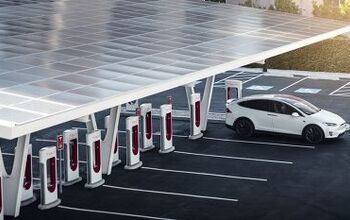Jaguar Isn't Giving Up on Sports Cars, But Don't Expect the Purity to Last

Think of the words “Jaguar” and “sports car” and the mind instantly conjures up images of the flowing XK120 and E-Type roadsters of yesteryear, each sporting a properly British straight-six engine under a kilometer-long hood. Okay, okay — the final E-Type variant doubled the cylinder count, but you get the idea.
The tradition of open-top two-seaters continues to this day with the F-Type, albeit with a much more diverse array of engine offerings. As the tech press talks up a future of autonomous people pods, and as crossovers threaten to overwhelm every longstanding brand, Jaguar wants automotive puritans to fear not: the Jaguar sports car isn’t going anywhere.
But that doesn’t mean it won’t change with the times.
Speaking at an event in Detroit last week, Jaguar design boss Ian Callum told Automotive News that the F-Type won’t be the last of the brand’s two-door sports car lineage. It’s just the latest.
“We are going to do another range of sports cars eventually,” said Callum. “[Sports cars] are not going to go away.”
Journos hailed the F-Type’s debut in early 2013 as a return to form for the brand, with the model coming on the heels — and borrowing a modified platform — of the four-seat XK series. Available in droptop and coupe variants, the F-Type offers powerplants ranging from fast enough to wild.
Still, great looks and thrilling handling dynamics aren’t a surefire indicator of sales. The F-Type, along with all other passenger cars, sport or otherwise, faces an existential threat from utility vehicles, driverless technology, and environmental regulators. There’s also healthy competition from within the segment. As well, some would-be buyers might see more practicality in a hotter F-Pace SUV.
“SUVs can get around a corner as quick as a sports car can, technology being what it is,” said Callum. “But there is something very emotional about a sports car that conveys the ultimate in the sense of performance and design.”
Hoping to sweeten the pot, Jaguar dropped a 296-horsepower turbocharged four into the base F-Type for 2018, allowing for a pre-delivery MSRP below the $60,000 threshold. Buyers can still opt for a supercharged V6 or V8, with 575 hp on tap for those willing to drop $122,000. However, after a healthy start to the year, the last two months have seen year-over-year U.S. sales drops, with July being the lowest showing since April of 2014. The 2015 model year was the F-Type’s best, with 4,629 units sold.
As there’s no successor in sight, Jaguar will do what it can to keep the F-Type fresh. Callum won’t say when we’ll see a new sports model, though Jaguar Land Rover’s North American CEO, Joe Eberhardt, confirmed to AN that the successor won’t rely solely on gasoline for propulsion. As the automaker switches to electrified powertrains starting in 2020, any sports car will share the same mold.
[Image: Jaguar Land Rover]

More by Steph Willems
Latest Car Reviews
Read moreLatest Product Reviews
Read moreRecent Comments
- Redapple2 I retract my comments and apologize.
- Flashindapan I always thought these look nice. I was working at a Land Rover dealership at the time the LR3 came out and we were all impressed how much better it was then the Discovery in just about every measurable way.
- Bd2 If I were going to spend $ on a ticking time bomb, it wouldn't be for an LR4 (the least interesting of Land Rovers).
- Spectator Wild to me the US sent like $100B overseas for other peoples wars while we clammer over .1% of that money being used to promote EVs in our country.
- Spectator got a pic of that 27 inch screen? That sounds massive!


































Comments
Join the conversation
4,000 to 5,000 US sales annually isn't bad, because I expect Jaguar sells at least that many again in other markets around the world. In comparison, global sales of the E-Type was just over 70,000 units over 14 years, or about 5,000 annually, but probably 80% of those went to the US.
"straight-six engine under a kilometer-long hood" That would be a mile-long bonnet dear chap. We'll have none of this garlic chomping measurement system or ex-colony language phrases used to describe our beautiful ladies :-)